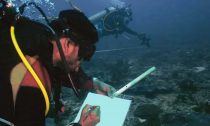
The state government has sent its final proposal to the Centre to notify 2,011.43 sq km Angria Bank – located 105km (56.7 nautical miles) off the Konkan coast – as a ‘designated area’ under the Maritime Zones Act, 1976, thereby inching towards India’s first marine protected zone beyond territorial waters.
“It is a very important step towards conservation and protection of marine biodiversity,” said Milind Mhaiskar, principal secretary (forests) who wrote to central bodies, the Ministry of Environment, Forests and Climate Change (MoEFCC) with a copy to the Ministry of External Affairs (MEA) on November 25.
Supporting coral reefs, algal habitats, and high diversity of marine flora and fauna, Angria Bank was identified among 106 important coastal and marine biodiversity areas in India by the Wildlife Institute of India, Dehradun.
“There is a high probability that surrounding waters are an important habitat for marine mammals. However, as it lies beyond the Indian territorial waters (12 nautical miles), it is not possible to declare the site as a protected area under the Wildlife Protection Act (WPA), 1972,” read the letter, adding, “Therefore, being in the exclusive economic zone (EEZ), the only way to provide legal protection is by notifying it as a ‘designated area’ for marine protection under the Maritime Zones Act, 1976, (covering territorial waters, continental shelf, exclusive economic zone, and other maritime zones) of the MEA.”
Angria Bank, located off Malvan in Sindhudurg district, is a submerged plateau with coral reef formation at a depth of 20 to 400 metres, home to 29 genera and 39 species of both hard and soft corals (protected under Schedule I of the WPA) across 650 sq km. The proposed boundary for protection is approximately 61-km long and 50-km wide.
MoEFCC said they were aware of the proposal. “Angria Bank is a very contentious issue. We need to read through submissions in detail to understand the significance of this declaration before taking any decision,” said Soumitra Dasgupta, additional director-general of forests (wildlife), MoEFCC.
After the Maharashtra mangrove cell (under the forest department) first proposed conserving the area on April 29, it was finally approved by the state government earlier this month.
“This is a major step forward as it will open new avenues for the conservation of corals and help address increasing natural events like coral bleaching (turning white due to rising sea surface temperatures as an aftermath of climate change). With more conservation focus there will be more protective measures, promotion of research, a bit of controlled tourism, and control over suspected threats,” said Nitin Kakodkar, PCCF-Wildlife.
This proposal is a first under the Maritime Zones Act, 1976. “There was no precedence to accord legal protection to such a marine area beyond territorial waters. Thus, every minor detail has been elaborated ensuring security concerns and focused approach to address every threat to this submerged plateau,” said Virendra Tiwari, additional principal chief conservator of forest (Mangrove Cell).
The state’s final proposal was based on underwater and boat surveys in collaboration with Centre for Marine Living Resources (CMLRE) under the Ministry of Earth Sciences and Wildlife Conservation Society (WCS)-India, Mangrove Foundation of Maharashtra and partner institutes. As many as 123 species of fish, 43 species of invertebrates, dolphins and whales among other marine animals protected under India’s wildlife laws were recorded. Threats including overfishing, oil, natural gas and mineral exploration, rising ocean temperatures, and rising marine traffic were identified.
“Submission of the final proposal is one of the last steps in ensuring this notification for protecting this pristine coral reef, adjoining seascape, and biodiversity comes through. The decision will help India meet international obligations for more protection of our marine biodiversity,” said Prakriti Srivastava, country director, WCS-India.
Marine biologist and scientist Deepak Apte said, “We must pursue this (an effort to protect this critically important reef) at the Central government-level for its early declaration.”











Social Profiles